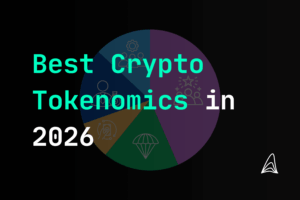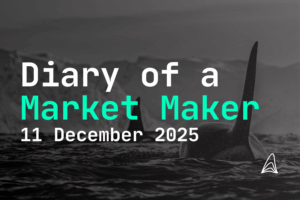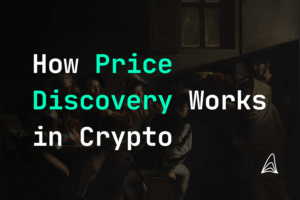
How to Define Token Properties - Market Maker’s Perspective
- Jakob Brezigar
- Last updated: 15.May 2024
- Reading time: 7 min
Alright, let’s dive into the nuts and bolts of defining token properties from a crypto market maker’s viewpoint. Think of it like crafting the perfect pizza: every ingredient (or token property) matters to get that perfect slice of the crypto pie. Let’s break down each token property, sprinkle in some humor, and clarify each of them.

Table of Contents
Why is the token name and symbol important?
The token name and symbol are vital for brand recognition. A catchy, memorable name and a distinctive symbol make it easier for users to identify and trade the token.
What is the purpose of setting decimal places in a token?
Decimal places determine the smallest unit of a token that can be traded, essential for microtransactions and precise pricing.
How does regulatory compliance affect tokens?
Regulatory compliance ensures that tokens can be legally traded and used, preventing fines or shutdowns and promoting trust among investors.
Key Takeaways - How to Define Token Properties:
- Choosing a memorable token name and symbol is crucial for brand recognition and market success.
- Setting the right total and initial supply balances scarcity and liquidity, impacting token value.
- Effective governance mechanisms ensure sustainable decision-making and investor trust in the token.
- Compliance with regulations is essential to avoid legal issues and ensure smooth trading operations.
- Interoperability and upgradeability of tokens enhance their usability and adaptability in the crypto market.
Token Properties and How to Define Them
Defining token properties isn’t just about slapping a name on a new crypto and calling it a day. It’s a careful balancing act of technical specifications and strategic decisions. Understanding each property helps in creating a robust token. Let’s take a closer look at each one, shall we?
Token Name
Choosing a token name is like naming your first pet—it needs to be memorable and meaningful. Your token name should resonate with your project’s goals and community. For example, something catchy yet relevant to your project’s ethos. Names that are too long or complex might be forgettable or hard to pronounce. Imagine explaining your token name at 5:30 AM when someone just wakes you up and asks you about it. You want it to roll off the tongue, even before your first coffee.

Token Symbol
If the token name is the pet’s name, the symbol is its cute little nickname. Symbols are usually three to four characters long and should be easy to remember. Think of it as the ticker symbol in stock markets—simple, recognizable, and synonymous with the token’s identity. Symbols need to be unique within their blockchain network. Picture trying to buy a token with a symbol that matches another—chaos, right? So, aim for something distinctive and snappy.
Decimal Places
Decimal places determine the smallest unit of the token that can be traded. This decision impacts the token’s usability, especially in microtransactions. A common standard is 18 decimal places, aligning with Ethereum’s ERC-20 standard, but this can vary based on the token’s intended use. More decimal places mean more granularity. Think of it like getting change for a dollar. Sometimes, you need those tiny fractions to make everything add up neatly.
Total Supply
Total supply is the maximum number of tokens that will ever exist. This number influences scarcity and, by extension, the token’s value. It’s a bit like printing money—too much and you risk inflation; too little and you might stifle liquidity. Deciding on the total supply is like setting the stage for your token’s entire lifecycle. Market makers need to balance between scarcity and availability. Imagine having too few tokens—traders might hoard them, leading to high prices but low liquidity.
Initial Supply
This is the number of tokens available at launch. It can be a subset of the total supply or the entire amount. Market makers often prefer a portion of the total supply to be released initially to control distribution and stabilize prices. Releasing a limited initial supply helps in managing demand and maintaining interest. This approach prevents market saturation and provides a steady introduction to the market, encouraging sustainable growth and gradual adoption by the user base.
Token Standard
The token standard (like ERC-20 token standard for Ethereum) dictates how the token operates on its respective blockchain. Choosing the right standard ensures compatibility with wallets, exchanges, and other infrastructure. It’s like picking the right foundation for your dream house. Token standards ensure that your token can fit nicely with others in the crypto ecosystem. The ERC-20 standard, for instance, has become the backbone of many tokens, ensuring smooth interactions.
Minting Rules
Burning Rules
Burning tokens reduces the total supply, often to increase scarcity and value. Clear burning rules help manage supply effectively and can boost investor confidence. Tokens can be burned as part of regular operations or specific events, like to counteract inflation or as a penalty for unwanted behaviors.

Governance
Governance refers to how decisions about the token are made. This can be centralized or decentralized, involving community votes or a central authority. Governance is crucial for long-term sustainability and investor trust. Effective governance mechanisms ensure that all stakeholders have a voice. Think of it as having a town hall meeting where everyone’s opinion counts, balancing power and ensuring fairness.
Utility
The token’s utility is its practical use within its ecosystem. It could be used for transactions, accessing services, or voting in governance. A token without utility is like a car without fuel—pretty, but useless. Tokens need to have a clear and compelling use case to boost adoption. The more useful a token, the more likely people will want to hold and use it.
Security Features
Security is paramount in the crypto world. This includes protecting against hacks, fraud, and ensuring the integrity of transactions. Robust security measures are essential to maintain trust and prevent financial loss. Security features can include encryption, multi-signature wallets, and regular audits. Advanced security protocols and continuous monitoring of the network also play crucial roles in safeguarding assets. Implementing these measures helps build confidence among users and investors, ensuring the long-term success and stability of the token.

Regulatory Compliance
Compliance with legal regulations ensures the token can be traded and used without legal issues. This varies by jurisdiction but is critical to avoid fines or shutdowns. Regulatory compliance often involves adhering to anti-money laundering (AML) and know your customer (KYC) requirements, among other legal standards.
Smart Contract Association
Tokens often rely on smart contracts for their functionality. These contracts automate processes and enforce rules without intermediaries. Proper smart contract development and auditing can prevent costly mistakes and ensure smooth operations. Smart contracts are like digital agreements that execute themselves when conditions are met. They need to be rock-solid to avoid loopholes and errors.
Token Distribution
How tokens are distributed at launch can affect their market performance. Fair and transparent distribution methods build trust and prevent market manipulation. Distribution strategies might include public sales, airdrops, or allocations to founders and early investors. A well-planned distribution ensures that no single entity can control the market.
Lock-up Periods
Lock-up periods restrict token sales by early investors to prevent market flooding. This helps stabilize prices post-launch and reassures new investors that early birds won’t dump their holdings immediately. Lock-up periods are like a cooling-off period—preventing hasty actions that could destabilize the market. These periods ensure that early stakeholders remain committed to the project’s long-term success.
Staking Mechanisms
Staking involves holding tokens to support network operations and earn rewards. It’s a way to incentivize holding rather than selling, thus reducing volatility. Think of it as earning interest on a savings account but with more blockchain flair. Staking mechanisms as a token property encourage participation in the network, providing benefits like rewards and governance rights to those who contribute.
Token Upgradeability
The ability to upgrade tokens allows for improvements and bug fixes post-launch. This flexibility can be crucial for adapting to market changes and technological advancements without needing to create a new token. Upgradeability ensures the token can evolve over time. This feature is vital for long-term viability.
Interoperability
Interoperability ensures the token can interact with other blockchains and systems. This expands the token’s usability and integration potential, making it a vital feature in the fragmented crypto landscape. Interoperability allows tokens to function across different platforms seamlessly, facilitating transactions and interactions within various ecosystems. This capability enhances the token’s appeal by increasing its versatility and utility, making it more attractive to users and developers. Additionally, interoperability supports broader adoption and integration, fostering a more connected and efficient blockchain environment.

Token Vesting Schedules
Vesting schedules dictate when team members and early investors can access their tokens. This prevents mass sell-offs and aligns long-term incentives, similar to stock options in traditional companies. Vesting schedules ensure that contributors remain committed to the project’s success over time. They stagger token releases to align with project milestones and achievements.
Transfer Restrictions
These restrictions control who can transfer tokens and when. They can be used to comply with regulations or prevent market manipulation. Transfer restrictions help in maintaining market stability and ensuring that tokens are used as intended.
Which Ones we Think are the Most Important to Get Right - Our Advice
From a crypto market maker’s perspective, nailing the total supply, token standard, distribution, and governance aspects are crucial. These properties ensure the token’s market stability, attract investors, and maintain a healthy trading environment. Getting these right creates a strong foundation for the token’s success.
Disclaimer: The information provided in this article is for informational purposes only and does not constitute financial, investment, or other professional advice. All opinions expressed herein are solely those of the author and do not represent the views or opinions of any entity with which the author may be associated. Investing in financial markets involves risk, including the potential loss of principal. Readers should perform their own research and consult with a licensed financial advisor before making any investment decisions. Past performance is not indicative of future results.

Jakob Brezigar
Jakob, an experienced specialist in the field of cryptocurrency market making, boasts an extensive international presence. With Orcabay, he has skillfully managed major operations and deals for a wide array of global stakeholders.



